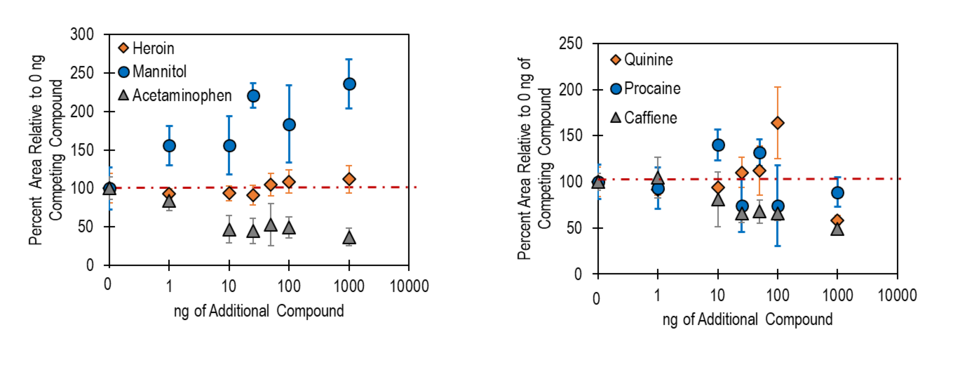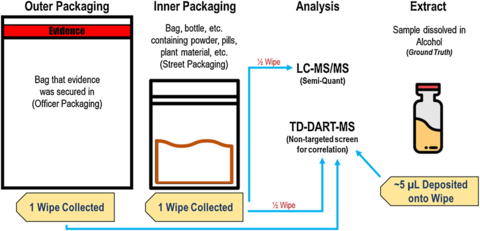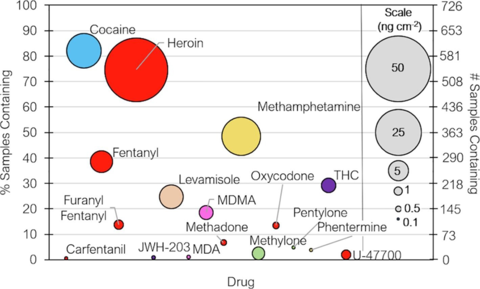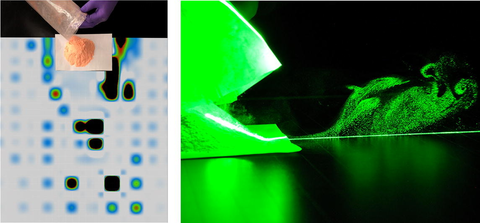Summary
The goal of this focus area is to enhance drug detection capabilities through the development of standard methods for the collection, analysis, and interpretation of drug samples. Many of these efforts focus on synthetic opioids and other novel psychoactive substances (NPSs) because of the unique analytical challenges they present. The projects cover a broad range of needs of end-users in both the field (first responders, law enforcement officers, public health officials, crime scene technicians, etc.) and in the laboratory. Projects in these areas focus on package interdiction, in-field detection and screening, and laboratory analysis.
Description
Package Interdiction
Many synthetic opioids and novel psychoactive substances enter the country through international mail. Research in this area focuses on measurement challenges associated with detection and analysis of these packages at the point of seizure in international mail facilities. Ongoing efforts in this area include:
Measuring Trace Drug Background in Package Interdiction Environments
This project aims to measure the trace drug background in operational environments for package interdiction scenarios. Through wipe collections, samples in operational environments are taken and used to obtain the quantitative and qualitative drug make-up. This information is then used to better address a range of questions from data quality to personnel health and safety risks to considerations for implementing detection technologies.
Measuring and Understanding the Nature of Trace Drug Residue on Packages
This project aims to establish the likelihood and circumstances under which trace drug residues are present on packages containing illicit substances. In collaboration with Department of Homeland Security counterparts, packages suspected of containing illicit substances are sampled and then analyzed to obtain quantitative values for a range of drugs of interest as well as qualitative preliminary identification of a large range of drugs. The data is then compared to results obtained from analysis of the bulk material, to understand what correlations exist. The project also aims to identify where on packages trace residues would be most likely encountered.
Measuring the Persistence of Trace Drug Residues
Achieving successful trace detection of drug residues requires that drug particulate is released from a source and settles on the surface of interest and that the residue is then able to persist in the environment until it is collected and analyzed. While other projects aim to address the question of whether trace particulate is being released and settling on surfaces, this project aims to address the question of environmental persistence. To measure persistence, trace amounts of drugs are exposed to a range of simulated environmental conditions for extended periods of time. Samples are then analyzed using mass spectrometric techniques to both quantify the amount of drug present and to understand the degradation processes. The project is investigating both novel and traditional drugs of abuse.
In-Field Detection and Screening
Detection and analysis of illicit drugs in the field continues to present a number of analytical challenges due to the high potency of these compounds coupled with changing chemical structures and the potential of complex mixtures. Research in this area focuses on investigating, developing, and understanding the role of existing and novel detection technologies for in-field screening. Efforts in this area include:
Understanding the Capabilities of New and Existing Technologies
Continuing efforts to combat the opioid crisis require technologies that can detect the presence of fentanyl and fentanyl-related substances in a range of applications. This project aims to develop methods for understanding the strengths and limitations of trace detection techniques used in synthetic opioid analysis. This project has studied a range of different technologies to understand how identification of multiple fentanyl analogs, the presence of cutting agents, and the presence of background interferences can affect results. One example, highlighted below, shows how cutting agents can have either deleterious or beneficial effects on fentanyl detection.

Understanding the Characteristics of Drug Evidence
Many of the technologies used for in-field screening rely on trace drug residues to be present on a surface, which are collected and analyzed. However, little research exists on the prevalence and nature of these residues. This project aims to better understand the characteristics of trace drug residues on drug evidence. In collaboration with multiple practicing forensic laboratories, seized items from interdictions are sampled and subsequently analyzed to understand the qualitative and quantitative nature of the residue on drug evidence. Using ground truth information from analysis of the bulk material, the correlation of the drug evidence residue and contents can be understood. The analytical approach for this project is shown below.

Laboratory Drug Analysis
Laboratory analysis of drug evidence is a critical component of all forensic analyses. Drug chemists are faced with a unique set of challenges and are required to balance safety and exposure probabilities with case backlog issues and a rapidly changing drug landscape. Projects focus on the challenges faced by drug chemists in analytical measurement and operations. Efforts in this area include:
Characterized Authentic Drug Samples (CADS)
This project aims to provide the community with access to authentic drug samples and related data to assist in research, method development, and method validation. Working with collaborating forensic laboratories, we obtain authentic materials, fully characterize them and then provide homogenized aliquots back to the community as Research Grade Test Materials (RGTMs). These materials and the associated data can be used by researchers and practitioners to ensure that newly developed methods and algorithms are fit for use when applied to real-world samples.
Development of a Novel Workflow for Forensic Drug Analysis
This project aims to develop a re-envisioned workflow for traditional drug analysis that provides higher fidelity information in a more rapid manner while also increasing the safety of the forensic chemist. Working with the Maryland State Police Forensic Sciences Divisions, the new workflow aims to eliminate colorimetric tests and GC-FID analyses with DART-MS analysis while also employing the use of targeted and batched GC-MS analyses. The utilization of DART-MS search software and GC-MS deconvolution software along with retention time locking and retention indices aims to increase the fidelity of the case results. Under this project other process, such as taking net weights, are also being evaluated and safer methods are being developed.
Tools for DART-MS Analysis of Forensic Samples
This project aims to provide the community with increased tools and resources for the implementation of DART-MS technology through the development of updated and freely available spectral libraries and search tools. This project will also allow for the development and testing of automated curation methods which may allow for more rapid updating of the library to be completed. The initial focus is on providing a spectral library of novel psychoactive substances and cutting agents. Concurrently, a new search tool is being developed that more heavily utilizes fragmentation data to provide users with increased confidence in presumptive compound identification.
Understanding Drug Background Levels and Their Contributing Processes
As drugs become increasingly potent and analytical instrumentation becomes more sensitive, the need to understand and monitor drug background levels becomes imperative. Background monitoring is commonplace in many other industries but has been largely overlooked in forensic laboratories. This project represents a multi-agency collaboration focused on establishing drug background levels in forensic laboratories and in understanding the implications for data quality, data integrity, and occupational health and safety.
Efforts in this project include conducting drug background studies in forensic laboratories to address questions arising from: processes that contribute to drug background; ensuring data quality; developing ways to reduce background; and strategies for self-monitoring. The foundational study for this work measured over 700 background wipes from 20 laboratories across the country, thereby providing insight into the level of background found on different surfaces and sections within the laboratory. A summary of this study is shown below.

Other efforts include visualizing and quantifying the role that different processes have on background contribution – processes such as net weights, crushing pills, and opening evidence, an example of which is shown below. Another important component of this work is understanding the potential occupational health and safety impact on the analyst.


